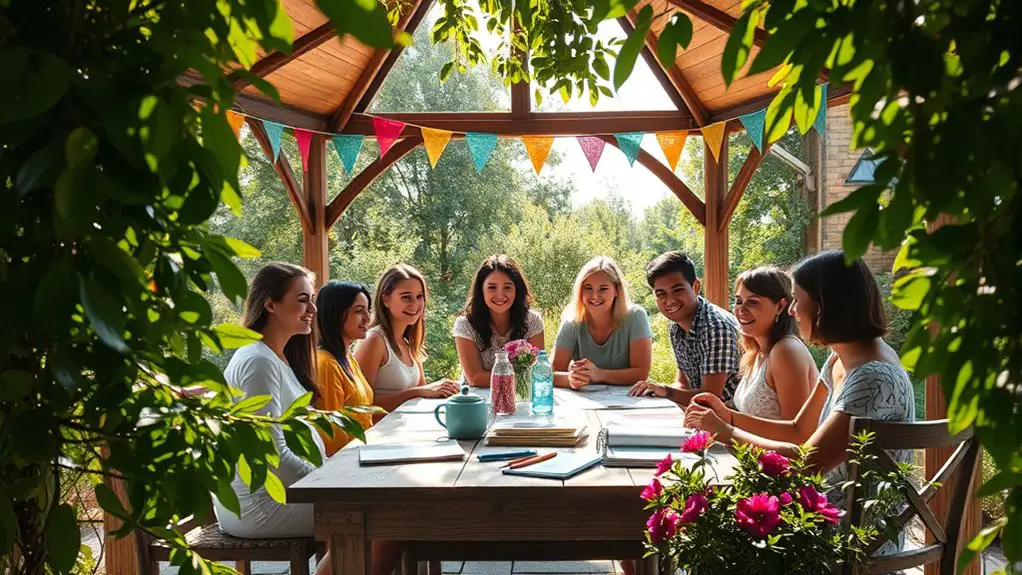Hosting a community workshop or meet-up in your gazebo is a great way to foster connections. Start by choosing a relevant theme based on community interests. Schedule it at a convenient time, and promote your event through social media and local businesses. Set up the gazebo with comfortable seating and warm lighting. Prepare materials to engage participants and encourage interaction. Finally, gather feedback afterward to improve future events. You’ll discover even more strategies to enhance your gathering.
Choosing the Right Theme for Your Workshop
When it comes to choosing the right theme for your workshop, what objectives do you want to achieve? Start by engaging in some creative brainstorming with your community. Consider their interests and needs—what topics resonate with them? This collaborative approach not only empowers participants but also fosters a sense of ownership.
Think about incorporating themes that allow for exploration and freedom, such as art, wellness, or environmental initiatives. These can spark enthusiasm and draw in diverse groups. It’s essential to align the theme with community interests; ask for input through informal surveys or casual conversations.
Once you’ve gathered insights, refine your theme to guarantee it’s both focused and relevant. The right theme can transform your workshop into a vibrant hub of ideas and connections. Remember, your goal is to inspire and unite, so let the community’s voice guide your choices.
Selecting the Ideal Time and Date
How do you determine the best time and date for your community workshop? Selecting the ideal moment is essential for maximizing attendance and engagement. Here are some steps to take into account:
Selecting the right time and date for your community workshop is crucial for boosting attendance and engagement.
- Assess Community Availability: Check local calendars for events or holidays that might conflict with your workshop.
- Evaluate Seasonal Factors: Different seasons can impact participation; for instance, summer may attract more outdoor enthusiasts.
- Poll Potential Attendees: Use social media or community boards to gauge when people are most available.
- Choose Convenient Times: Evening or weekend slots often work best for busy families and professionals.
Promoting Your Event Effectively
Once you’ve settled on the perfect time and date for your workshop, the next step is to guarantee that your community knows about it. Effective promotion can greatly boost attendance. Utilize social media platforms to spread the word—create engaging posts, share eye-catching images, and encourage your friends to share.
Local partnerships can also amplify your reach. Collaborate with nearby businesses or community organizations to promote your event through their networks.
Here’s a simple plan to help you promote:
| Method | Description | Benefits |
|---|---|---|
| Social Media | Post regularly on platforms | Wide reach and engagement |
| Flyers | Distribute in local hotspots | Targets community directly |
| Partnerships | Team up with local businesses | Mutual promotion opportunities |
Setting Up the Gazebo for Comfort and Functionality
To guarantee your gazebo is both comfortable and functional for the workshop, you’ll want to carefully consider its layout and amenities. Here are some key elements to focus on:
- Seating Arrangement: Opt for flexible seating that can be arranged in a circle or U-shape to encourage interaction and communication.
- Lighting Options: Utilize string lights or lanterns to create a warm atmosphere, especially if your workshop extends into the evening.
- Weather Protection: Ascertain you have adequate shade or coverings to protect against unexpected weather changes, keeping everyone comfortable.
- Accessibility: Make sure pathways are clear and accessible for all participants, catering to various mobility needs. Additionally, consider installing mosquito netting to enhance comfort and keep pests away during the workshop.
Preparing Materials and Resources
Now that your gazebo is set up, it’s time to focus on preparing the materials and resources you’ll need for your workshop. Start by creating an essential supplies checklist to guarantee you have everything on hand, from handouts to seating arrangements. Additionally, consider how you’ll use visual aids and participant engagement tools to enhance interaction and learning. Utilizing a gazebo can enhance outdoor space aesthetics and create a more inviting atmosphere for your community gathering.
Essential Supplies Checklist
A well-prepared workshop can transform your gazebo into a vibrant hub of creativity and collaboration. To guarantee smooth supply organization, gather these essential tools before your event:
- Seating and Tables: Make sure everyone’s comfortable with adequate seating and table space.
- Writing Materials: Provide pens, markers, and notepads for participants to jot down ideas.
- Refreshments: Keep energy levels high with snacks and beverages for everyone.
- Activity Supplies: Depending on your workshop, gather any specific items needed, like craft materials or handouts.
Visual Aids Preparation
With the logistics of seating, writing materials, and refreshments covered, it’s time to focus on visual aids that can enhance your workshop experience. Using various visual aids types, like slideshows, charts, and handouts, can make your presentations more engaging and informative. Prepare clear and concise visuals that highlight key points; this’ll guarantee your audience stays focused and retains information. Consider using large print for readability and incorporating images or infographics to illustrate concepts effectively. Keep your visuals organized and aligned with your presentation flow, promoting a seamless shift between topics. Remember, effective presentations rely on strong visual support, so take time to prepare these materials in advance for a smoother workshop experience.
Participant Engagement Tools
Effective participant engagement tools are essential for fostering interaction and collaboration during your workshop. To keep your audience involved and motivated, consider these engagement strategies:
- Interactive Polls: Use feedback tools like live polls to gather opinions and insights from participants in real-time.
- Breakout Groups: Divide attendees into smaller groups for discussions, encouraging diverse perspectives.
- Visual Prompts: Provide visual aids that inspire creativity, sparking conversations and ideas.
- Feedback Stations: Set up areas for participants to leave comments or suggestions, enhancing their sense of ownership in the workshop.
Engaging Participants During the Workshop
To make your workshop engaging, start with some icebreaker activities that encourage participants to connect. Consider incorporating interactive group exercises that promote collaboration and creativity. These strategies not only warm up the crowd but also foster a sense of community throughout the event. Additionally, hosting the workshop in a gazebo can provide shelter from elements, creating a comfortable environment for participants to fully engage.
Icebreaker Activities Ideas
How can you break the ice and foster a sense of community at your workshop? Engaging activities can set a welcoming tone. Here are some fun ideas:
- Name Games: Have participants share their names and a unique fun fact about themselves.
- Speed Networking: Pair participants for quick conversations, rotating every few minutes to meet more people.
- Team Challenges: Create small groups to tackle a light-hearted task or problem together, promoting collaboration.
- Story Sharing: Encourage participants to share a brief personal story related to the workshop theme.
These icebreaker activities not only enhance connections but also energize your participants, making them more comfortable to engage fully in the workshop!
Interactive Group Exercises
Engaging participants during your workshop is essential for fostering collaboration and creativity, and incorporating interactive group exercises can make a significant difference. Start with team building activities that encourage trust and communication, like a simple human knot or trust fall. These exercises break down barriers and help participants feel connected. Next, facilitate creative brainstorming sessions where everyone can share ideas without judgment. Use techniques like mind mapping or rapid ideation to spark innovation. Allow people to rotate between groups, ensuring diverse perspectives. Don’t forget to wrap up with a group reflection, where participants can discuss their experiences and insights. By integrating these exercises, you’ll create an atmosphere of freedom and creativity that inspires engagement and collaboration.
Encouraging Networking and Interaction
While hosting a community workshop in your gazebo, fostering networking and interaction among participants can greatly enhance the experience. Here are some effective networking strategies and interaction techniques to contemplate:
- Ice Breaker Activities: Start with fun introductions or quirky questions to create a relaxed atmosphere.
- Small Group Discussions: Divide participants into smaller groups to encourage deeper conversations and connections.
- Networking Stations: Set up designated areas where attendees can share their interests, skills, or projects, facilitating more focused interactions.
- Follow-Up Opportunities: Provide a platform for participants to exchange contact information, ensuring they can connect after the event. Additionally, consider the size and available outdoor space of your gazebo when planning activities to ensure comfort and accessibility for all attendees.
Gathering Feedback and Suggestions
After facilitating networking and interaction, it’s important to gather feedback and suggestions to improve future workshops. Implementing effective feedback collection methods can enhance the experience for everyone involved. A suggestion box is a simple yet powerful tool to encourage participants to share their thoughts.
You can also create a feedback form that participants can fill out, either digitally or on paper. Here’s a quick overview of the methods you might use:
| Method | Description |
|---|---|
| Suggestion Box | Anonymous input during the event |
| Feedback Form | Structured questions for clarity |
| One-on-One Chat | Personal conversations after the event |
| Digital Survey | Online platform for easy access |
Following up With Attendees After the Event
Once the event wraps up, following up with attendees is essential for nurturing relationships and reinforcing community connections. A thoughtful follow-up can make a lasting impression. Here are some key steps to reflect upon:
Following up with attendees is crucial for building lasting relationships and enhancing community ties after an event.
- Send thank you emails: Express your gratitude for their attendance and contributions. Personalizing each message can enhance the connection.
- Distribute follow up surveys: Gather feedback on the event to understand what worked well and what can be improved. This shows you value their opinions.
- Share highlights: Send a recap of the event, including photos and key takeaways. This keeps the conversation going and reminds attendees of the community spirit.
- Invite future engagement: Encourage attendees to participate in upcoming events or join community initiatives. This fosters ongoing involvement and strengthens bonds.
Frequently Asked Questions
What if It Rains on the Day of the Workshop?
If it rains on the day, don’t worry! Have backup plans ready, like an indoor space or a virtual option. A rainy day can still be productive with some creativity and flexibility in your approach.
How Many Participants Can the Gazebo Accommodate?
The gazebo’s maximum capacity depends on seating arrangements. Typically, it can comfortably accommodate around 20-30 participants. Consider flexible seating to enhance engagement, allowing everyone to participate freely and enjoy the experience together.
Can I Charge a Fee for the Workshop?
You can absolutely charge a fee for your workshop! Just consider your pricing strategies carefully, ensuring the workshop value is clear to participants. They’ll happily pay if they see the benefits you offer.
Are There Any Permits Required for Hosting Events?
You should check local event regulations, as permits might be required for gatherings. It’s wise to review permit applications early to guarantee you’re compliant, allowing you to focus on enjoying your event without hassle.
What if I Need to Cancel or Reschedule?
If you need to cancel or reschedule, check your cancellation policy and explore rescheduling options. Communicate promptly with attendees, ensuring they’re informed of changes, which helps maintain trust and keeps everyone on the same page.

